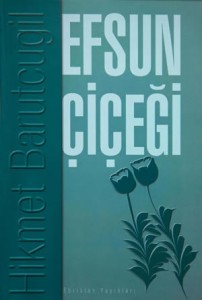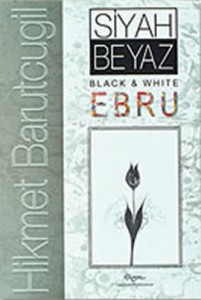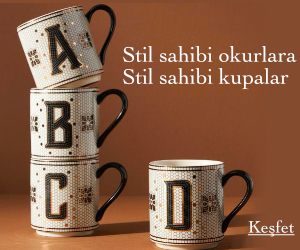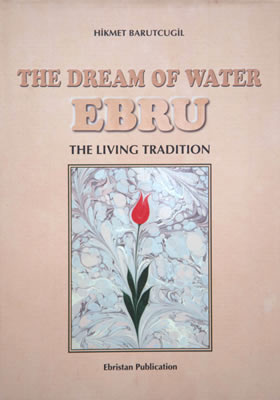
Sırlar âlemini suya yansıtan, aşk dolu, neşe dolu bir sanat olan ebru; yoğunlaştırılmış su yüzeyinde yüzdürülen boyaların kağıda alınmasıyla oluşur. Yüzyıllar önce Orta Asya’da başlayan Ebru Sanatı, İran üzerinden Anadolu’ya geldi, “Türk Kâğıdı” adıyla Avrupa’ya gitti. Kâğıdın ve Ebru Sanatı’nın geçmişten bugüne tarihî süreci ve ebru ustalarıyla ilgili bilgiler. Geleneksel Ebru Sanatı’nın uygulamasında kullanıla bütün araç-gereçler. Bunların nasıl hazırlandıklarıyla ilgili bilgiler; at kuyruğu ve gül dalından fırça yapımı, topraktan boya elde edilmesi..
Hazırlanan bu malzelerle nasıl ebru yapılacağı açıklanmıştır. Geleneği olan ebru türleri görsel örnekleriyle verilmiştir. Ebru yaparken karşılaşılabilecek sorunlar, bunların sebepleri ve çareleri adlı bir bölüm de bulunmaktadır. Ebru yapmak isteyen herkese, çocuğa, yetişkine, zanaatkâra ve sanatkâra, ihtiyaç duyduğu bütün temel bilgileri ve bu bilgileri ve bu bilgileri nasıl kullanacağını açıklar. İngilizce olarak yazılan, konusunun en kapsamlı kitabıdır.
***
He was bom in 1952. In 1973, he began taking Textile classesat the Industrial Art Department of the State Academy of Art in Istanbul. Motivated by Prof. Emin Barın, a calligraphy teacher he met during his first year, he discovered the Art of Marbling. During his individual and independent studies, he mastered tarditional marbling and developed a new style known in the west as “Barut Marbling”. Barutcugil went beyond paper and started applying marbling to different types of surfaces, making an interesting contribution to the world of interior design. Hikmet Barutcugil has held 46 exhibitions and has participated in 63 conferences, clases and seminars in the U.K., Spain, USA, Germany, Pakistan, Switzerland, Tunisia, Denmark, Syria, Egypt, Sweden, India, Canada, Puerto Rico and Austria. Also he has held 34 exhibition and 46 courses and seminars to Turkey.
The artist exhibits his works in prestigious museums (such as The British Museum) and private collections around the world. Barutcugil, who has organized the 4th Marbling Meeting in Istanbul, still teaches at Ebristan (his very own Marbling Workshop in Istanbul), at the Traditional Turkish Handcrafts Department of Mimar Sinan University and at the Internationale Grsellschaft fur Musik-Ethnologie und Kunstherapy Forschung in Austria. Hikmet Barutcugil has previously published the three books and a wide number of articles on the Art of Marbling.
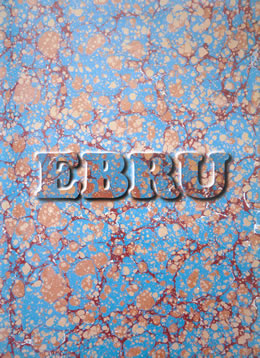 |
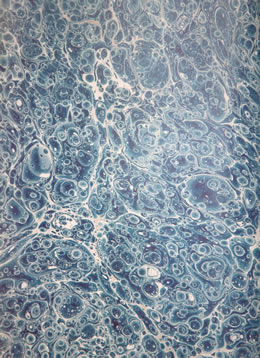 |
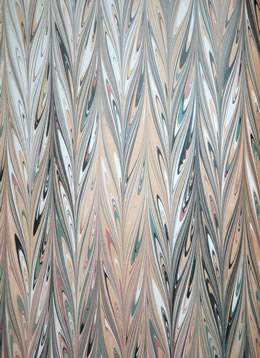 |
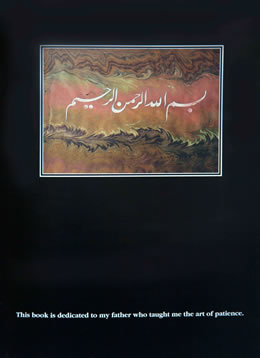 |
CONTENTS
Gratitude
14
Annemarie Schimmel
15
Beşir Ayvazoğlu
17
Preface
23
The Turkish Art of Marbling
27
Introduction
29
History
33
Materials Used in Marbling
55
The Application of Marbling
73
Traditional Marbling Patterns
83
Flowery Marbling
115
Some of the Problems We Might Encounter During Marbling, Their Causes and Solutions
143
Conclusion
155
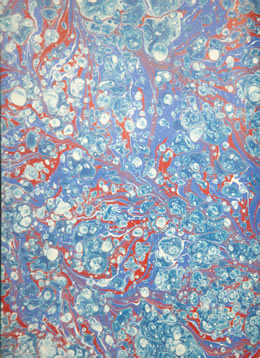 |
Gratitude
I am especially grateful to my teacher the late Prof. Dr. Emin Barın for initiating me to the art of marbling. This book has come to life with the endeavours and editorship of my dear friend §ems ibrahimhakkioglu. I would like to especially thank my beloved wife Ftisun Barutcugil for her continuous support over the years of preparation; Nur Atabay, an ardent art lover; to my brother Prof. Dr. İsmet Barutcugil; to my dear friend Beşir Ayvazoğlu for sharing his thoughts with me on the aesthetic principles of Islam; Polat Erol; Nil Kutay; Filiz Oal and Ms. Lynne Jackson for their help in the translations; my friend, graphic designer Osman Kehri; Mrs. Fatma M. Sinclair, Yasemin Kunze Concewitz, my dear students Gül Ergül and Serra Güney; Ayşe and Aras Neftç, for their help in photography; the late Mr. Nusret Hepgül for his invaluable donations to the Library of Süleymaniye, which I have used in my book, to the Library Director Mr. Nevzat Kaya for allowing me to research; my assistants Sema Balkaya and Hacer Ünal; all my teachers and colleagues who have shared their vast knowledge and experience with me; and my special thanks to Belkis İbrahimhakkıoğlu and Emine Karabulut for the graphic design of the book.
A. Hikmet Barutcugil
Mimar Sinan University
Department of Traditional Turkish Handcrafts
Annemarie Schimmel
There are thousands of wonders in the Islamic world.
Since ancient times, calligraphers, architects, painters and many many artists have manifested, with their works, the creative power of God in the world, rightfully bringing the saying “Inne Allah cemil yuhibbu’l cemal”* to life. The art of marbling has a special place among the arts created by the Muslims. This art developed and advanced among the Indians and Ottomans in the middle ages, from Turkey to Italy, and from there to central Europe, and became known as “Türkisch Papier” or Turkish paper in Germany. This paper was and still is greatly valued by art and beauty lovers.
A person gazing on the works of marblers is amazed, amazed at the imagination of the artists and the capabilities of their hands. The marbler shows us the forms from the spiritual and material world in comparison to the visible world. The roses and tulips growing in celestial gardens with the miraculous force of the brush take shape on the paper in exciting forms.
In this book Hikmet Barutcugil, one of the masters of this art, explains the development of his art and some of its mystery to his readers.
Our master, who belongs to the line of famous marblers, has dedicated all his life to this difficult art and with his friends and students has tried to promote the art of marbling in the east and west. I am sure that the readers of this book will greatly enjoy it. I congratulate the author from my heart and while presenting my best wishes I pray:
“God save marblers”
*
Beşir Ayvazoğlu
How many people know Hezarfen Edhem Efendi, who was the Sheik of the Özbekler dervish lodge in Üskudar? I am sure that if I mention that he is the grandfather of the Ertegün brothers, founders of the Atlantic record company in USA and fathers of jazz and pop music, many of my readers will be surprised and will pay more attention to what I am writing. As for me, I think he was one of the last stars of a world coming to an end. Living at the end of the last century and in the first 4 years of this century, he was a master of unequalled exellence in carpentry, engraving, seal making, ink making, ahar making, metal working and lathe operating; a blacksmith and a machinist. He was famous for his interest in machines and personally built a 3 HP steam machine which he mounted on his boat and went to and fro from Balaban İskele to Paşalimanı.
Edhem Efendi, an inventor of the likes of Ebu’l-iz, Hezarfen Ahmed Efendi and Lagari Hasan Çelebi, was the sole representative at that time of the art of marbling, which is being revived again today. The late Necmeddin Okyay took this art from him and brought it to the present day, presenting it in a new style and shape unknown to his predecessor. Carnations, hyacinths, tulips, pansies, jonquils and poppies first bloomed in his basin. He was also the first one to trv calligraphy on marbling. That is why marbling with flowers and writing are called Necmeddin marbling in literature.
Marbling was continued by Sacid Okyay, Niyazi Savin, Ali Alpaslan, Uğur Derman and Mustafa Düzgünman who took their art from Necmeddin Okyay and transmitted to the next generation. One can find the spirit of Hezarfen Edhem and Necmeddin Efendi in all the lodges that are found today, but there is one marbling basin which has come from outside this chain of transmission: the basin of Barutcugil. Born in 1952 in Malatya, Hikmet Barutcugil continued his education in Istanbul where his family settled in 1960. After graduating from the Vefa Lycée in 1971, he became a student of the late Emin Barm in the Textile Department at the State Academy of Fine Arts, School for Applied Arts and Design.
Emin Barın, a great master in the art of classic book binding, brought a graphic style to the art of calligraphy by producing especially beautiful arrangements in kufi script. He often complained that the young people in his classes did not show an interest in old traditional arts. He tried to motivate his students to learn these arts. One day, he was telling the class about how a specialist from Spain had been brought in 1950 to restore the inscription on the main entrance gate of the university in Beyazit because there was no one else to do it in Turkey. Hikmet Barutcugil suddenly was all ears and from then on showed a great interest towards our traditional arts.
He approached the only artist he knew in the city who was his teacher Emin Barın and started to practice calligraphy with him. He inspected, with his teacher’s advice, the works of great calligraphers at the Siileymaniye Library and one day noticed the marblings in the background and borders. Naturally he would learn from his teacher what this beauty was and again with his advice, went to the Herbalist Shop in Üsküdar to find Mustafa Düzgünman. The year was 1973. Unfortunately Düzgünman was no longer interested in marbling and was not giving any lessons. The disapointed young man started to read all the writings he could find and after inspecting the old examples of marbling, started to work by himself. Some days he succeeded, in spite of great fear, disappointment, hopelessness and heartbeats in obtaining beautiful colours and forms. This got him excited and with greater enthusiasm he continued to discover the mystery of marbling and took command of his basin. Now one marbling after another is more beautiful and the mvsterious world of colour and form opens out to him.
Marbling is in fact quite a bewitching art, where an artist on learning its exact language, will see an abstract beauty of a world open to them. A moment later their pulse will beat the same as the colours in the basin and the abstract forms. After that, a basin that is prepared is an adventure of its own and a journey of discovery. You can say that this is a mystical journey. The final production of a masterpiece is not the image of a phenomenon or a description but impressions and snapshots of a journey made to the source of eternal beauty. As for those who learn the language of marbling half-heartedly, they continue to struggle in a repetitious effort. Barutcugil is one of those who has really learnt the language. He himself says that the education he received from the academy plays an important role in his success. He continues meanwhile to experiment in the interest of discovering new innovations that can be made in marbling, knowing that innovations are not welcomed by classic marblers. He regards this reaction as natural but also believes that in marbling, as in other old traditional arts, new innovations have to be made to adapt to the new life. According to him, if marbling was not protected with all these strict rules it would never have survived until our day. But in contrast, if new experiments are not made, it is difficult for it to live on.
The innovations he has tried with courage in marbling, such as experimenting with different paints, different materials and working in larger sizes, made it difficult for Hikmet Barutcugil to open an exhibition in Turkey. Therefore he readily accepted an offer from the Royal College of Art in London in 1987 for an exhibition there, and with the intent of staying 3 weeks to open the exhibition, stayed for 3 months.
This experience showed him the possibility of reintroducing the art of marbling to Europe. As a matter of fact he completed some of his must significant work abroad and formed especially close friendships with American marblers. Many marblers live in the USA. There are close to 15 books on the subject and a journal entitled “Ink and Gall”. The American marblers, who came to Turkey, had an important article on Barutcugil published in this journal and even gave the name “barut marbling” to his style. Two articles by Barutcugil on Mustafa Düzgünman and marbling on ceramics were published in the same journal, and finally the doors of Turkey opened opened to him.
Barutcugil participated in an interesting artistic event in England called “Art in Action”. The purpose of this event organized by The School of Economic Science in Oxford, was to demonstrate the production of handcrafts. After searching for the means to organize an “Art in Action” in Turkey for several years, he came close to realizing his dream in June, 1997, by organizing the 4th International Marblers Conference entitled Beyond the Surface”, which brought marblers from all over the world to Istanbul. The Conference inculuded exhibitions, symposiums, and sema” (dance of whirling dervishes). More importantly it marked the opening of Ebristan, an establishment dedicated to the art of marbling.
The red mansion bought and restored by Hikmet Barutcugil was now a house, a workshop for marbling and a gallery for the exhibition of marbling and other traditional arts. This mansion, one of 12 mansions in the İhsaniye sector of Üsküdar, was built by Sultan Mahmud II in 1830 and donated to the pasha active at the military barracks. If this house, whose first owner was İzzettin Pasha, had not been not bought by Barutcugil, it would have been replaced by a modern apartment as the other eleven had.
I do not know how to describe Ebristan; overlooking the Bosphorus and directly across Sarayburnu. It dominates the classic silhouette of İstanbul and is decorated in all of its details by the hands and eves of Hikmet Barutcugil. It is a jewel of a house, a marbling museum. Ebristan, overtaking the duty of the Özbekler lodge in Üsküdar at the end of the last century, will transfer the art of marbling to the next generation. A nice coincidence. And a true Hezarfen lives there who excells in everything: Hikmet Barutcugil.
Bu kitabı en uygun fiyata Amazon'dan satın alın
Diğerlerini GösterBurada yer almak ister misiniz?
Satın alma bağlantılarını web sitenize yönlendirin.
- Kategori(ler) Türk El Sanatları
- Kitap AdıThe Dream Of Water Ebru - The Living Tradition
- Sayfa Sayısı160
- YazarHikmet Ahmet Barutçugil
- ISBN9789759363819
- Boyutlar, Kapak23x33, Karton Kapak
- YayıneviEbristan Yayınları / 2005
